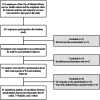Development and Validation Study of a Screening Questionnaire to Identify People Who Are Physically Inactive
- PMID: 40496103
- PMCID: PMC12039349
- DOI: 10.1002/puh2.70037
Development and Validation Study of a Screening Questionnaire to Identify People Who Are Physically Inactive
Abstract
Objective: Insufficient physical activity (PA) is a well-known risk factor for many non-communicable diseases. This study aimed to develop a screening tool, the Helsinki Physical Activity Questionnaire (HPAQ), to identify physically inactive people at the population level and to help social and health care professionals promote PA among people at risk.
Methods: Eighty-five healthy adults wore a hip-worn accelerometer for 7 days, after which they completed several PA questionnaires. These included some novel and several validated questions on PA. The reliability of individual questions to identify physically inactive people was assessed by correlation analysis. Logistic regression analysis was used to find the combination of questions that best identified physically inactive people.
Results: The highest correlation of the screening questionnaire with the accelerometer was 0.46 (p < 0.001) for sedentary behavior (SB) and 0.42 (p < 0.001) for the total amount of moderate-to-vigorous physical activity (MVPA), respectively. The best pair of questions on total PA identified 64% of all inactive subjects (MVPA < 150 min/week) based on accelerometer data.
Conclusions: The questionnaires developed for screening PA have a poor correlation with the accelerometer data. The screening questionnaires roughly describe PA level among middle-aged participants, but if a more sensitive or specific method is needed, device-based measurements are recommended.
Keywords: mass screening; physical activity; questionnaire; sedentary behaviors; validation.
© 2025 The Author(s). Public Health Challenges published by John Wiley & Sons Ltd.
Conflict of interest statement
The authors declare no conflicts of interest.
Similar articles
-
Associations of emotional/behavioral problems with accelerometer-measured sedentary behavior, physical activity and step counts in children with autism spectrum disorder.Front Public Health. 2022 Oct 10;10:981128. doi: 10.3389/fpubh.2022.981128. eCollection 2022. Front Public Health. 2022. PMID: 36299767 Free PMC article.
-
Socio-demographic patterning of objectively measured physical activity and sedentary behaviours in eight Latin American countries: Findings from the ELANS study.Eur J Sport Sci. 2020 Jun;20(5):670-681. doi: 10.1080/17461391.2019.1678671. Epub 2019 Oct 30. Eur J Sport Sci. 2020. PMID: 31603392 Clinical Trial.
-
Reliability and validity of a Global Physical Activity Questionnaire adapted for use among pregnant women in Nepal.Arch Public Health. 2023 Feb 10;81(1):18. doi: 10.1186/s13690-023-01032-3. Arch Public Health. 2023. PMID: 36759922 Free PMC article.
-
Effects of Consumer-Wearable Activity Tracker-Based Programs on Objectively Measured Daily Physical Activity and Sedentary Behavior Among School-Aged Children: A Systematic Review and Meta-analysis.Sports Med Open. 2022 Jan 31;8(1):18. doi: 10.1186/s40798-021-00407-6. Sports Med Open. 2022. PMID: 35099630 Free PMC article.
-
Folic acid supplementation and malaria susceptibility and severity among people taking antifolate antimalarial drugs in endemic areas.Cochrane Database Syst Rev. 2022 Feb 1;2(2022):CD014217. doi: 10.1002/14651858.CD014217. Cochrane Database Syst Rev. 2022. PMID: 36321557 Free PMC article.
References
-
- Physical Activity Guidelines Advisory Committee , Physical Activity Guidelines Advisory Committee Scientific Report (U.S. Department of Health and Human Services, 2018), https://odphp.health.gov/our‐work/nutrition‐physical‐activity/physical‐a....
-
- Garber C., Blissmer B., Deschenes M., et al., “American College of Sports Medicine Position Stand. Quantity and Quality of Exercise for Developing and Maintaining Cardiorespiratory, Musculoskeletal, and Neuromotor Fitness in Apparently Healthy Adults: Guidance for Prescribing Exercise,” Medicine & Science in Sports & Exercise 43, no. 7 (2011): 1334–1359, 10.1249/MSS.0b013e318213fefb. - DOI - PubMed
-
- Biddle S., Ciaccioni S., Thomas G., and Vergeer I., “Physical Activity and Mental Health in Children and Adolescents: An Updated Review of Reviews and an Analysis of Causality,” Psychology of Sport and Exercise 42 (2019): 146–155, 10.1016/j.psychsport.2018.08.011. - DOI
LinkOut - more resources
Full Text Sources

